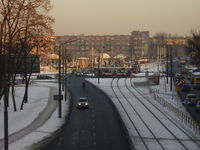Dąbrowa Górnicza
| Dąbrowa Górnicza | |||
|---|---|---|---|
 |
|||
|
|||
 Dąbrowa Górnicza
|
|||
| Coordinates: | |||
| Country | |||
| Voivodeship | |||
| County | city county | ||
| Town rights | 1916 | ||
| Government | |||
| - Mayor | Zbigniew Podraza | ||
| Area | |||
| - City | 188 km2 (72.6 sq mi) | ||
| Population (2009) | |||
| - City | 128,040 | ||
| - Density | 681.1/km2 (1,763.9/sq mi) | ||
| - Urban | 2,746,000 | ||
| - Metro | 5,294,000 | ||
| Time zone | CET (UTC+1) | ||
| - Summer (DST) | CEST (UTC+2) | ||
| Postal code | 41-300 to 42-530 | ||
| Area code(s) | +48 32 | ||
| Car plates | SD | ||
| Sister cities: | |||
| Website | http://www.dabrowa-gornicza.pl/ | ||
Dąbrowa Górnicza [dɔmˈbrɔva ɡurˈnit͡ʂa] (![]() listen) is a city in Zagłębie Dąbrowskie in southern Poland, near Katowice. The north-east district of the Upper Silesian Metropolitan Union - metropolis with the population of 2 millions. Located in the Silesian Highlands, on the Czarna Przemsza and Biała Przemsza rivers (tributaries of the Vistula).
listen) is a city in Zagłębie Dąbrowskie in southern Poland, near Katowice. The north-east district of the Upper Silesian Metropolitan Union - metropolis with the population of 2 millions. Located in the Silesian Highlands, on the Czarna Przemsza and Biała Przemsza rivers (tributaries of the Vistula).
It is situated in the Silesian Voivodeship since its formation in 1999, previously it was in Katowice Voivodeship. Dąbrowa Górnicza is one of the cities of the 2,7 million conurbation - Katowice urban area and within a greater Silesian metropolitan area populated by about 5,294,000 people.[1] The population of the city is 128,040 (June 2009).[2]


Contents |
History
In the first half of the 18th century Dąbrowa was a small agricultural settlement belonging to the Będzin parish. First mentioned in 1726. According to a census of the Archdiocese of Kraków from 1787 the settlement numbered 184 inhabitants. After the Third Partition of Poland (1795) incorporated into the Prussian province of New Silesia. The Prussians discovered rich deposits of coal here and the first coal mine was established by Friedrich Wilhelm von Reden in 1796. The settlement started to grow in 19th century. The Huta Bankowa steel works, which is still a going concern, was built in Dąbrowa Górnicza in 1834. The 1970s saw the construction of the Huta Katowice steel works, which is nowadays the biggest steel producing plant in Poland, after privatization owned by ArcelorMittal. In the 1970s the town expanded teritorially and economically. In 1975 and 1977 the neighboring localities of Strzemieszyce Małe, Strzemieszyce Wielkie, Ząbkowice and others became suburbanized. The population of Dąbrowa Górnicza reached its peak in 1982 with 152,373 inhabitants. In the 1990s all coal mines there had been closed, because of lack of coal. But the oldest part of the town Reden still exists.

Education
- Silesian Technical University, Faculty of Chemistry, Industrial and Environmental Chemistry course
- Wyższa Szkoła Biznesu
- Wyższa Szkoła Planowania Strategicznego

Transport
There are many important routes crossing in Dąbrowa Górnicza. These include expressway S1 and national road 94. Expressway S1 is a direct connection to motorway A4 and to Katowice International Airport. Also Dąbrowa Górnicza has rich railway network access including Warsaw-Katowice line (VI Pan-European corridor) and nearby Broad Gauge Metallurgy Line terminal in Sławków.
Famous people born in Dąbrowa Górnicza
- Karol Adamiecki (1866–1933), economist, engineer
- Janusz Gajos (b. 1939), actor
- Sobieslaw Zasada (b. 1930), rally driver, businessman


Etymology of Dąbrowa Górnicza
The place name "Dąbrowa", derived from the Polish word dąb (oak), denotes an "oak grove", as the territory of the original village is believed to be covered by oak forests back in the early days of its existence. Since in the 19th century the settlement grew to be an important coal mining center, its name was supplemented by the adjective "Górnicza" ("mining") in 1919.
References
- ↑ European Spatial Planning Observation Network (ESPON)[1]
- ↑ Central Statistical Office, Warsaw 2009, "Population. Size and Structure by Territorial Division, as of June 30, 2009" (PDF). http://www.stat.gov.pl/cps/rde/xbcr/gus/PUBL_L_ludnosc_stan_struktura_30_06_2009.pdf. Retrieved 2009-12-31.
External links
- Encyclopaedia Britannica Dabrowa Gornicza
- Dabrowa Gornicza page for investors
- Forum about Dabrowa Gornicza
- The City of Dabrowa Gornicza
|
||||||||||


